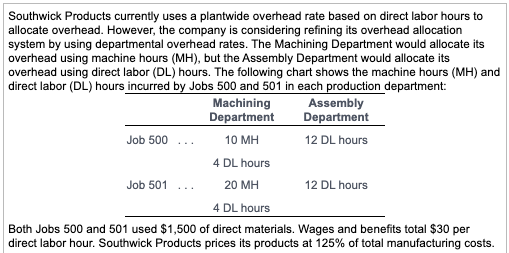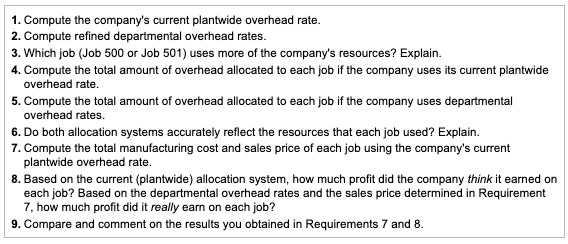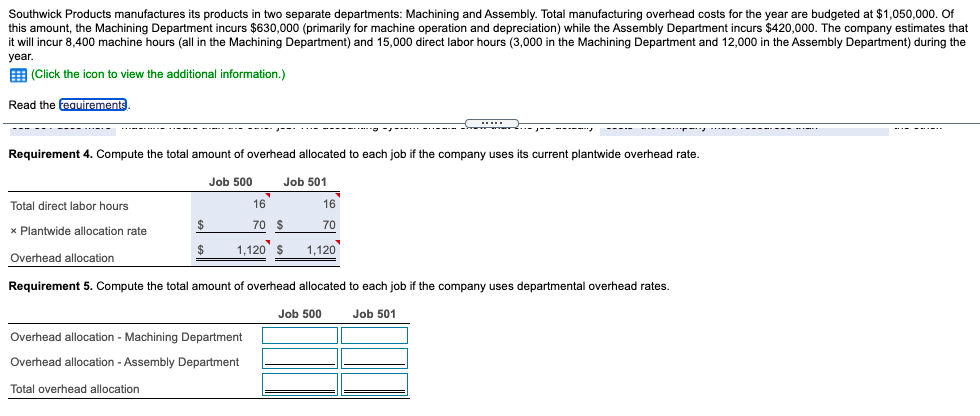Answered step by step
Verified Expert Solution
Question
1 Approved Answer
Please finish, this is one problem, i just need 5-9 Southwick Products currently uses a plantwide overhead rate based on direct labor hours to allocate



Please finish, this is one problem, i just need 5-9
Southwick Products currently uses a plantwide overhead rate based on direct labor hours to allocate overhead. However, the company is considering refining its overhead allocation system by using departmental overhead rates. The Machining Department would allocate its overhead using machine hours (MH), but the Assembly Department would allocate its overhead using direct labor (DL) hours. The following chart shows the machine hours (MH) and direct labor (DL) hours incurred by Jobs 500 and 501 in each production department: Machining Assembly Department Department Job 500 10 MH 12 DL hours 4 DL hours Job 501 20 MH 12 DL hours 4 DL hours Both Jobs 500 and 501 used $1,500 of direct materials. Wages and benefits total $30 per direct labor hour. Southwick Products prices its products at 125% of total manufacturing costs. 1. Compute the company's current plantwide overhead rate. 2. Compute refined departmental overhead rates. 3. Which job (Job 500 or Job 501) uses more of the company's resources? Explain. 4. Compute the total amount of overhead allocated to each job if the company uses its current plantwide overhead rate. 5. Compute the total amount of overhead allocated to each job if the company uses departmental overhead rates. 6. Do both allocation systems accurately reflect the resources that each job used? Explain. 7. Compute the total manufacturing cost and sales price of each job using the company's current plantwide overhead rate. 8. Based on the current (plantwide) allocation system, how much profit did the company think it earned on each job? Based on the departmental overhead rates and the sales price determined in Requirement 7, how much profit did it really earn on each job? 9. Compare and comment on the results you obtained in Requirements 7 and 8. Southwick Products manufactures its products in two separate departments: Machining and Assembly. Total manufacturing overhead costs for the year are budgeted at $1,050,000. Of this amount, the Machining Department incurs $630,000 (primarily for machine operation and depreciation) while the Assembly Department incurs $420,000. The company estimates that it will incur 8,400 machine hours (all in the Machining Department) and 15,000 direct labor hours (3,000 in the Machining Department and 12,000 in the Assembly Department) during the year. (Click the icon to view the additional information.) Read the fequirements ------ ---------- Requirement 4. Compute the total amount of overhead allocated to each job if the company uses its current plantwide overhead rate. Job 500 Job 501 Total direct labor hours 16 16 x Plantwide allocation rate 70 70 $ 1,120 $ $ 1,1209 Overhead allocation Requirement 5. Compute the total amount of overhead allocated to each job if the company uses departmental overhead rates. Job 500 Job 501 Overhead allocation - Machining Department Overhead allocation - Assembly Department Total overhead allocation Southwick Products currently uses a plantwide overhead rate based on direct labor hours to allocate overhead. However, the company is considering refining its overhead allocation system by using departmental overhead rates. The Machining Department would allocate its overhead using machine hours (MH), but the Assembly Department would allocate its overhead using direct labor (DL) hours. The following chart shows the machine hours (MH) and direct labor (DL) hours incurred by Jobs 500 and 501 in each production department: Machining Assembly Department Department Job 500 10 MH 12 DL hours 4 DL hours Job 501 20 MH 12 DL hours 4 DL hours Both Jobs 500 and 501 used $1,500 of direct materials. Wages and benefits total $30 per direct labor hour. Southwick Products prices its products at 125% of total manufacturing costs. 1. Compute the company's current plantwide overhead rate. 2. Compute refined departmental overhead rates. 3. Which job (Job 500 or Job 501) uses more of the company's resources? Explain. 4. Compute the total amount of overhead allocated to each job if the company uses its current plantwide overhead rate. 5. Compute the total amount of overhead allocated to each job if the company uses departmental overhead rates. 6. Do both allocation systems accurately reflect the resources that each job used? Explain. 7. Compute the total manufacturing cost and sales price of each job using the company's current plantwide overhead rate. 8. Based on the current (plantwide) allocation system, how much profit did the company think it earned on each job? Based on the departmental overhead rates and the sales price determined in Requirement 7, how much profit did it really earn on each job? 9. Compare and comment on the results you obtained in Requirements 7 and 8. Southwick Products manufactures its products in two separate departments: Machining and Assembly. Total manufacturing overhead costs for the year are budgeted at $1,050,000. Of this amount, the Machining Department incurs $630,000 (primarily for machine operation and depreciation) while the Assembly Department incurs $420,000. The company estimates that it will incur 8,400 machine hours (all in the Machining Department) and 15,000 direct labor hours (3,000 in the Machining Department and 12,000 in the Assembly Department) during the year. (Click the icon to view the additional information.) Read the fequirements ------ ---------- Requirement 4. Compute the total amount of overhead allocated to each job if the company uses its current plantwide overhead rate. Job 500 Job 501 Total direct labor hours 16 16 x Plantwide allocation rate 70 70 $ 1,120 $ $ 1,1209 Overhead allocation Requirement 5. Compute the total amount of overhead allocated to each job if the company uses departmental overhead rates. Job 500 Job 501 Overhead allocation - Machining Department Overhead allocation - Assembly Department Total overhead allocationStep by Step Solution
There are 3 Steps involved in it
Step: 1

Get Instant Access to Expert-Tailored Solutions
See step-by-step solutions with expert insights and AI powered tools for academic success
Step: 2

Step: 3

Ace Your Homework with AI
Get the answers you need in no time with our AI-driven, step-by-step assistance
Get Started


